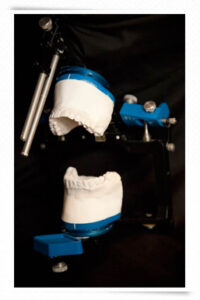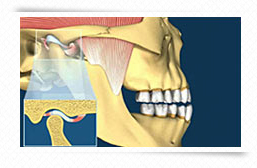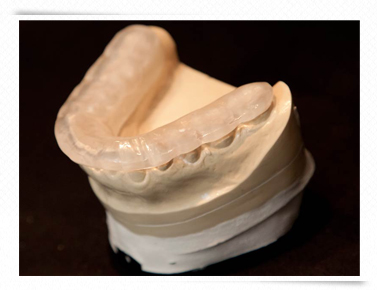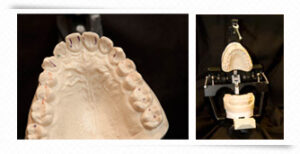The care offered by your dentist
FUNCTIONAL DENTISTRY
Occlusion
 The occlusion is defined by the way the teeth close together and by the way of chewing. Having a good occlusion results in teeth that wear little and remain stable for a long time, as well as muscles and joints free of tension and pain.
The occlusion is defined by the way the teeth close together and by the way of chewing. Having a good occlusion results in teeth that wear little and remain stable for a long time, as well as muscles and joints free of tension and pain.
Treatment of the musculature for temporomandibular dysfunction may include exercises, physiotherapy, osteopathy, chiropractic, acupuncture, biofeedback, dietary counseling, application of ice packs , medication, immobilization, etc.
Serious temporomandibular dysfunction issues may require further x-rays and a coordinated treatment plan with other healthcare professionals,
Bite problems
At any time in life, one may experience pain or snapping in the jaw joint area. Several factors can be the cause. But most often it is the jaw muscles that cause these problems. We are rarely in the presence of a pathology of the joint, such as arthritis.
Signs and symptoms
Bite problems can lead to problems like chipped, worn teeth (once in dentin, teeth wear out six times faster than normal. So your teeth wear out faster the further you go in chronological age), unstable teeth as well as deficient joints and painful muscles. We assess the severity of bite problems by observing the following signs and symptoms:
- worn teeth
- Unstable or loose teeth
- Muscle or joint discomfort
Unstable or loose teeth (bite trauma)
Normal chewing pressure does not cause loosening of teeth unless there is infection or periodontal disease (loss of bone). Teeth clenching or excessive chewing pressure can, however, loosen teeth from healthy bone. Also, an inflamed periodontium and teeth that don’t fit together properly can lead to loose teeth, despite normal chewing. These conditions can cause discomfort and lead to premature tooth loss.
Muscle or joint discomfort (temporomandibular dysfunction)
 Temporomandibular dysfunction is the term generally used to describe clinical problems with the muscles of mastication and the temporomandibular joints. It can cause facial pain. This dysfunction can be constant or intermittent, and the symptoms vary considerably from one individual to another.
Temporomandibular dysfunction is the term generally used to describe clinical problems with the muscles of mastication and the temporomandibular joints. It can cause facial pain. This dysfunction can be constant or intermittent, and the symptoms vary considerably from one individual to another.
Evaluation and diagnosis by the dentist
A functional analysis in several stages of the dentition during the examination gives us the information necessary for a diagnosis. This analysis requires us to take diagnostic impressions, a facebow, a bite impression and photographs, if necessary. After the analysis of the occlusion problems, a tailor-made treatment plan is established.
Difficult chewing, worn teeth, changes in the position of the teeth or pain in the jaw joints are warning signs of difficulties and should normally prompt the subject to consult the dentist.
Treatment options
- Further functional analysis to establish a final treatment plan.
- Bite plate (joint therapy), teeth protection.
- Major occlusion equilibration.
- Maintenance and reassessment.
- Tooth reconstruction.
- Diet modification.

Bite plate; joint therapy
An acrylic night gutter can be custom made. It is designed to fit either lower or upper teeth, protect tooth contact surfaces and minimize excessive pressure on the jaw muscles and joint. This initial occlusive and muscle therapy treatment is considered a conservative and reversible approach.
A splint, also known as a bite plate, used as a corrective, is also used to check if the jaw has moved back or if the bite has improved. If the improvement was obtained with the gutter, it can be worn continuously. The occlusion can also be corrected to eliminate the need for a splint.
Bite plates, usually made of acrylic resin, are subject to breakage and wear. Usually, it is used for a relatively short period of a few months. However, in cases of bruxism or frequent clenching of teeth, wearing an occlusal plate during sleep, which provides some comfort, may be necessary throughout life. Its periodic replacement must then be planned.
Occlusion equilibration
 Major occlusal equilibration may require selective grinding of the chewing surfaces of existing restorations, normal teeth (teeth may remain sensitive for a few months), fixed crowns or bridges in an attempt to find a stable position with good contacts, equal on each side. Some restorations may need to be changed after these treatments.
Major occlusal equilibration may require selective grinding of the chewing surfaces of existing restorations, normal teeth (teeth may remain sensitive for a few months), fixed crowns or bridges in an attempt to find a stable position with good contacts, equal on each side. Some restorations may need to be changed after these treatments.
This aspect of oral health is often overlooked or forgotten. At CDMD, we have acquired knowledge concerning this essential aspect of the dentition, good functionality.
